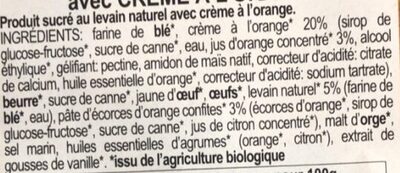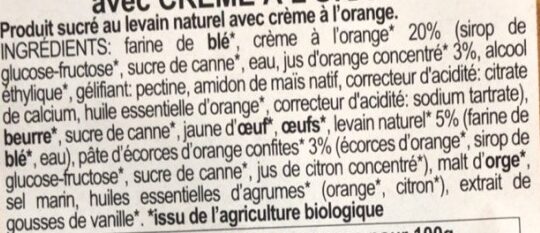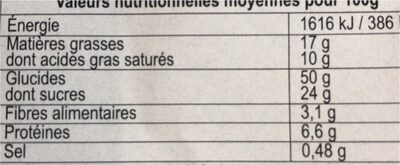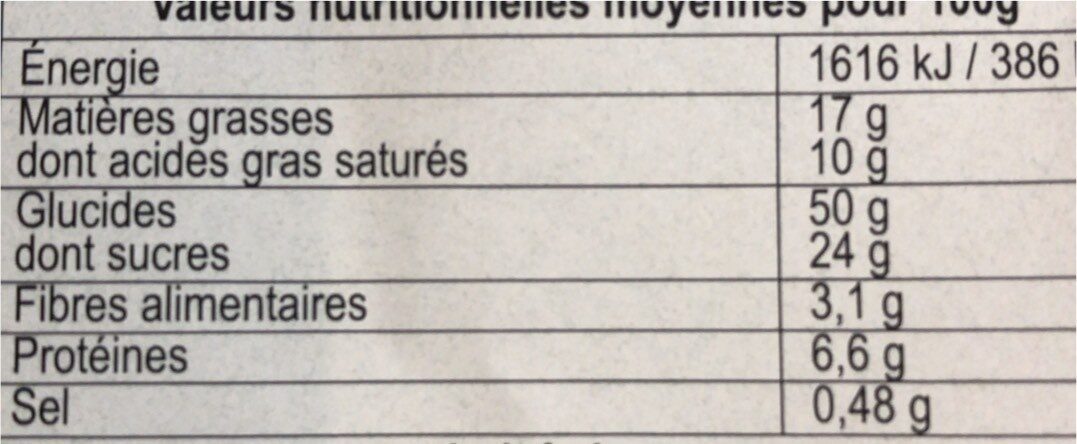Help us make food transparency the norm!
As a non-profit organization, we depend on your donations to continue informing consumers around the world about what they eat.
The food revolution starts with you!
Panettone bio avec crème à l'orange - Pasticceria del Castello - 500 g
Panettone bio avec crème à l'orange - Pasticceria del Castello - 500 g
This product page is not complete. You can help to complete it by editing it and adding more data from the photos we have, or by taking more photos using the app for Android or iPhone/iPad. Thank you!
×
Barcode: 8006073110020 (EAN / EAN-13)
Quantity: 500 g
Brands: Pasticceria del Castello
Categories: Snacks, Sweet snacks, Sweet pastries and pies, Viennoiseries, Brioches, Panettone
Labels, certifications, awards:
Organic, EU Organic, Non-EU Agriculture, EU Agriculture, EU/non-EU Agriculture, IT-BIO-006, AB Agriculture Biologique

Manufacturing or processing places: Italie, Fraccaro Spumadoro S.p.A., Via Circonvallazione Ovest 25/27 - 31033 - Castelfranco Veneto (TV), Italia
Countries where sold: France
Matching with your preferences
Health
Ingredients
-
33 ingredients
: Farine de blé*, crème à l'orange 20% (sirop de glucose-fructose*, sucre de canne*, eau, jus d'orange concentré* 3%, alcool éthylique*, gélifiant : pectine, amidon de maïs natif, correcteur d'acidité : citrate de calcium, huile essentielle d'orange*, correcteur d'acidité : sodium tartrate), beurre*, sucre de canne", jaune d'œuf*, œufs*, levain naturel* 5% (farine de blé*, eau), pâte d'écorces d'orange confites* 3% (écorces d'orange*, sirop de glucose-fructose*, sucre de canne*, jus de citron concentré*), malt d'orge*, sel marin, huiles essentielles d'agrumes (orange*, citron*), extrait de gousses de vanille* *issu de l'agriculture biologiqueAllergens: Eggs, Gluten, Milk, Orange
Food processing
-
Ultra processed foods
Elements that indicate the product is in the 4 - Ultra processed food and drink products group:
- Additive: E440 - Pectins
- Ingredient: Gelling agent
- Ingredient: Glucose
Food products are classified into 4 groups according to their degree of processing:
- Unprocessed or minimally processed foods
- Processed culinary ingredients
- Processed foods
- Ultra processed foods
The determination of the group is based on the category of the product and on the ingredients it contains.
Additives
-
E1510 - Ethanol
Ethanol: Ethanol, also called alcohol, ethyl alcohol, grain alcohol, and drinking alcohol, is a chemical compound, a simple alcohol with the chemical formula C2H5OH. Its formula can be also written as CH3−CH2−OH or C2H5−OH -an ethyl group linked to a hydroxyl group-, and is often abbreviated as EtOH. Ethanol is a volatile, flammable, colorless liquid with a slight characteristic odor. It is a psychoactive substance and is the principal type of alcohol found in alcoholic drinks. Ethanol is naturally produced by the fermentation of sugars by yeasts or via petrochemical processes, and is most commonly consumed as a popular recreational drug. It also has medical applications as an antiseptic and disinfectant. The compound is widely used as a chemical solvent, either for scientific chemical testing or in synthesis of other organic compounds, and is a vital substance used across many different kinds of manufacturing industries. Ethanol is also used as a clean-burning fuel source.Source: Wikipedia
-
E333 - Calcium citrates
Calcium citrate: Calcium citrate is the calcium salt of citric acid. It is commonly used as a food additive -E333-, usually as a preservative, but sometimes for flavor. In this sense, it is similar to sodium citrate. Calcium citrate is also found in some dietary calcium supplements -e.g. Citracal-. Calcium makes up 24.1% of calcium citrate -anhydrous- and 21.1% of calcium citrate -tetrahydrate- by mass. The tetrahydrate occurs in nature as the mineral Earlandite.Source: Wikipedia
-
E440 - Pectins
Pectins (E440) are natural carbohydrates, predominantly found in fruits, that act as gelling agents in the food industry, creating the desirable jelly-like texture in jams, jellies, and marmalades.
Pectins stabilize and thicken various food products, such as desserts, confectioneries, and beverages, ensuring a uniform consistency and quality.
Recognized as safe by various health authorities, pectins have been widely used without notable adverse effects when consumed in typical dietary amounts.
Ingredients analysis
-
Palm oil content unknown
Unrecognized ingredients: fr:creme-a-l-orange, fr:sodium-tartrate, fr:pate-d-ecorces-d-orange-confites, fr:huiles-essentielles-d-agrumesSome ingredients could not be recognized.
We need your help!
You can help us recognize more ingredients and better analyze the list of ingredients for this product and others:
- Edit this product page to correct spelling mistakes in the ingredients list, and/or to remove ingredients in other languages and sentences that are not related to the ingredients.
- Add new entries, synonyms or translations to our multilingual lists of ingredients, ingredient processing methods, and labels.
If you would like to help, join the #ingredients channel on our Slack discussion space and/or learn about ingredients analysis on our wiki. Thank you!
-
Non-vegan
Non-vegan ingredients: Butter, Egg yolk, EggSome ingredients could not be recognized.
We need your help!
You can help us recognize more ingredients and better analyze the list of ingredients for this product and others:
- Edit this product page to correct spelling mistakes in the ingredients list, and/or to remove ingredients in other languages and sentences that are not related to the ingredients.
- Add new entries, synonyms or translations to our multilingual lists of ingredients, ingredient processing methods, and labels.
If you would like to help, join the #ingredients channel on our Slack discussion space and/or learn about ingredients analysis on our wiki. Thank you!
-
Vegetarian status unknown
Unrecognized ingredients: fr:creme-a-l-orange, Orange essential oil, fr:sodium-tartrate, Sourdough, fr:pate-d-ecorces-d-orange-confites, fr:huiles-essentielles-d-agrumesSome ingredients could not be recognized.
We need your help!
You can help us recognize more ingredients and better analyze the list of ingredients for this product and others:
- Edit this product page to correct spelling mistakes in the ingredients list, and/or to remove ingredients in other languages and sentences that are not related to the ingredients.
- Add new entries, synonyms or translations to our multilingual lists of ingredients, ingredient processing methods, and labels.
If you would like to help, join the #ingredients channel on our Slack discussion space and/or learn about ingredients analysis on our wiki. Thank you!
-
Details of the analysis of the ingredients
We need your help!
Some ingredients could not be recognized.
We need your help!
You can help us recognize more ingredients and better analyze the list of ingredients for this product and others:
- Edit this product page to correct spelling mistakes in the ingredients list, and/or to remove ingredients in other languages and sentences that are not related to the ingredients.
- Add new entries, synonyms or translations to our multilingual lists of ingredients, ingredient processing methods, and labels.
If you would like to help, join the #ingredients channel on our Slack discussion space and/or learn about ingredients analysis on our wiki. Thank you!
: Farine de _blé_, crème à l'orange 20% (sirop de glucose-fructose, sucre de canne, eau, jus d'orange concentré 3%, alcool éthylique, gélifiant (pectine), amidon de maïs natif, correcteur d'acidité (citrate de calcium), huile essentielle d'orange, correcteur d'acidité (sodium tartrate)), _beurre_, sucre de canne", jaune d'_œuf_, _œufs_, levain naturel 5% (farine de _blé_, eau), pâte d'écorces d'orange confites 3% (écorces d'orange, sirop de glucose-fructose, sucre de canne, jus de citron concentré), malt d'_orge_, sel marin, huiles essentielles d'agrumes (orange, citron), gousses de vanille- Farine de _blé_ -> en:wheat-flour - labels: en:organic - vegan: yes - vegetarian: yes - ciqual_proxy_food_code: 9410 - percent_min: 20 - percent_max: 52
- crème à l'orange -> fr:creme-a-l-orange - percent_min: 20 - percent: 20 - percent_max: 20
- sirop de glucose-fructose -> en:glucose-fructose-syrup - labels: en:organic - vegan: yes - vegetarian: yes - ciqual_food_code: 31077 - percent_min: 3 - percent_max: 11
- sucre de canne -> en:cane-sugar - labels: en:organic - vegan: yes - vegetarian: yes - ciqual_proxy_food_code: 31016 - percent_min: 3 - percent_max: 7
- eau -> en:water - vegan: yes - vegetarian: yes - ciqual_food_code: 18066 - percent_min: 3 - percent_max: 5.66666666666667
- jus d'orange concentré -> en:concentrated-orange-juice - labels: en:organic - vegan: yes - vegetarian: yes - ciqual_proxy_food_code: 2070 - percent_min: 3 - percent: 3 - percent_max: 3
- alcool éthylique -> en:e1510 - labels: en:organic - vegan: yes - vegetarian: yes - percent_min: 0 - percent_max: 3
- gélifiant -> en:gelling-agent - percent_min: 0 - percent_max: 2.75
- pectine -> en:e440a - vegan: yes - vegetarian: yes - percent_min: 0 - percent_max: 2.75
- amidon de maïs natif -> en:native-corn-starch - vegan: yes - vegetarian: yes - ciqual_food_code: 9510 - percent_min: 0 - percent_max: 2.2
- correcteur d'acidité -> en:acidity-regulator - percent_min: 0 - percent_max: 1.83333333333333
- citrate de calcium -> en:e333 - vegan: yes - vegetarian: yes - percent_min: 0 - percent_max: 1.83333333333333
- huile essentielle d'orange -> en:orange-essential-oil - labels: en:organic - from_palm_oil: no - percent_min: 0 - percent_max: 1.57142857142857
- correcteur d'acidité -> en:acidity-regulator - percent_min: 0 - percent_max: 1.375
- sodium tartrate -> fr:sodium-tartrate - percent_min: 0 - percent_max: 1.375
- _beurre_ -> en:butter - labels: en:organic - vegan: no - vegetarian: yes - ciqual_proxy_food_code: 16400 - percent_min: 5 - percent_max: 20
- sucre de canne" -> en:cane-sugar - vegan: yes - vegetarian: yes - ciqual_proxy_food_code: 31016 - percent_min: 5 - percent_max: 20
- jaune d'_œuf_ -> en:egg-yolk - labels: en:organic - vegan: no - vegetarian: yes - ciqual_food_code: 22002 - percent_min: 5 - percent_max: 17.4
- _œufs_ -> en:egg - labels: en:organic - vegan: no - vegetarian: yes - ciqual_food_code: 22000 - percent_min: 5 - percent_max: 12.5
- levain naturel -> en:sourdough - labels: en:organic - percent_min: 5 - percent: 5 - percent_max: 5
- farine de _blé_ -> en:wheat-flour - labels: en:organic - vegan: yes - vegetarian: yes - ciqual_proxy_food_code: 9410 - percent_min: 2.5 - percent_max: 5
- eau -> en:water - vegan: yes - vegetarian: yes - ciqual_food_code: 18066 - percent_min: 0 - percent_max: 2.5
- pâte d'écorces d'orange confites -> fr:pate-d-ecorces-d-orange-confites - labels: en:organic - percent_min: 3 - percent: 3 - percent_max: 3
- écorces d'orange -> en:orange-zest - labels: en:organic - vegan: yes - vegetarian: yes - ciqual_proxy_food_code: 13034 - percent_min: 0.75 - percent_max: 3
- sirop de glucose-fructose -> en:glucose-fructose-syrup - labels: en:organic - vegan: yes - vegetarian: yes - ciqual_food_code: 31077 - percent_min: 0 - percent_max: 1.5
- sucre de canne -> en:cane-sugar - labels: en:organic - vegan: yes - vegetarian: yes - ciqual_proxy_food_code: 31016 - percent_min: 0 - percent_max: 1
- jus de citron concentré -> en:concentrated-lemon-juice - labels: en:organic - vegan: yes - vegetarian: yes - ciqual_food_code: 2028 - percent_min: 0 - percent_max: 0.75
- malt d'_orge_ -> en:malted-barley - labels: en:organic - vegan: yes - vegetarian: yes - percent_min: 0 - percent_max: 3
- sel marin -> en:sea-salt - vegan: yes - vegetarian: yes - ciqual_food_code: 11082 - percent_min: 0 - percent_max: 0.48
- huiles essentielles d'agrumes -> fr:huiles-essentielles-d-agrumes - percent_min: 0 - percent_max: 0.48
- orange -> en:orange - labels: en:organic - vegan: yes - vegetarian: yes - ciqual_proxy_food_code: 13034 - percent_min: 0 - percent_max: 0.48
- citron -> en:lemon - labels: en:organic - vegan: yes - vegetarian: yes - ciqual_proxy_food_code: 13009 - percent_min: 0 - percent_max: 0.24
- gousses de vanille -> en:vanilla-pod - labels: en:organic - vegan: yes - vegetarian: yes - percent_min: 0 - percent_max: 0.48
Nutrition
-
Poor nutritional quality
⚠ ️Warning: the amount of fruits, vegetables and nuts is not specified on the label, it was estimated from the list of ingredients: 3This product is not considered a beverage for the calculation of the Nutri-Score.
Positive points: 3
- Proteins: 4 / 5 (value: 6.6, rounded value: 6.6)
- Fiber: 3 / 5 (value: 3.1, rounded value: 3.1)
- Fruits, vegetables, nuts, and colza/walnut/olive oils: 0 / 5 (value: 3.28125, rounded value: 3.3)
Negative points: 20
- Energy: 4 / 10 (value: 1616, rounded value: 1616)
- Sugars: 5 / 10 (value: 24, rounded value: 24)
- Saturated fat: 9 / 10 (value: 10, rounded value: 10)
- Sodium: 2 / 10 (value: 192, rounded value: 192)
The points for proteins are not counted because the negative points are greater or equal to 11.
Nutritional score: (20 - 3)
Nutri-Score:
-
Nutrient levels
-
Fat in moderate quantity (17%)
What you need to know- A high consumption of fat, especially saturated fats, can raise cholesterol, which increases the risk of heart diseases.
Recommendation: Limit the consumption of fat and saturated fat- Choose products with lower fat and saturated fat content.
-
Saturated fat in high quantity (10%)
What you need to know- A high consumption of fat, especially saturated fats, can raise cholesterol, which increases the risk of heart diseases.
Recommendation: Limit the consumption of fat and saturated fat- Choose products with lower fat and saturated fat content.
-
Sugars in high quantity (24%)
What you need to know- A high consumption of sugar can cause weight gain and tooth decay. It also augments the risk of type 2 diabetes and cardio-vascular diseases.
Recommendation: Limit the consumption of sugar and sugary drinks- Sugary drinks (such as sodas, fruit beverages, and fruit juices and nectars) should be limited as much as possible (no more than 1 glass a day).
- Choose products with lower sugar content and reduce the consumption of products with added sugars.
-
Salt in moderate quantity (0.48%)
What you need to know- A high consumption of salt (or sodium) can cause raised blood pressure, which can increase the risk of heart disease and stroke.
- Many people who have high blood pressure do not know it, as there are often no symptoms.
- Most people consume too much salt (on average 9 to 12 grams per day), around twice the recommended maximum level of intake.
Recommendation: Limit the consumption of salt and salted food- Reduce the quantity of salt used when cooking, and don't salt again at the table.
- Limit the consumption of salty snacks and choose products with lower salt content.
-
-
Nutrition facts
Nutrition facts As sold
for 100 g / 100 mlCompared to: Panettone Energy 1,616 kj
(386 kcal)+2% Fat 17 g +8% Saturated fat 10 g +9% Carbohydrates 50 g -2% Sugars 24 g -7% Fiber 3.1 g +50% Proteins 6.6 g -3% Salt 0.48 g +11% Fruits‚ vegetables‚ nuts and rapeseed‚ walnut and olive oils (estimate from ingredients list analysis) 3.281 %
Environment
-
Eco-Score C - Moderate environmental impact
⚠ ️Select a country in order to include the full impact of transportation.The Eco-Score is an experimental score that summarizes the environmental impacts of food products.→ The Eco-Score was initially developped for France and it is being extended to other European countries. The Eco-Score formula is subject to change as it is regularly improved to make it more precise and better suited to each country.Life cycle analysis
-
Average impact of products of the same category: B (Score: 64/100)
Category: Brioche
Category: Brioche
- PEF environmental score: 0.39 (the lower the score, the lower the impact)
- including impact on climate change: 3.37 kg CO2 eq/kg of product
Stage Impact Agriculture
78.2 %Processing
12.8 %Packaging
6.1 %Transportation
2.7 %Distribution
0.2 %Consumption
0.0 %
Bonuses and maluses
-
Labels with high environmental benefits
Bonus: +15
-
AB Agriculture Biologique
Organic agriculture contributes to preserve biodiversity, climate, water quality and soil fertility.
Organic food is food produced by methods complying with the standards of organic farming and features practices that cycle resources, promote ecological balance, and conserve biodiversity.
-
EU Organic
Organic agriculture contributes to preserve biodiversity, climate, water quality and soil fertility.
Organic food is food produced by methods complying with the standards of organic farming and features practices that cycle resources, promote ecological balance, and conserve biodiversity.
-
-
Missing origins of ingredients information
Malus: -5
⚠ ️ The origins of the ingredients of this product are not indicated.
If they are indicated on the packaging, you can modify the product sheet and add them.
If you are the manufacturer of this product, you can send us the information with our free platform for producers.
-
Missing packaging information for this product
Malus: -15
⚠ ️ The information about the packaging of this product is not filled in.⚠ ️ For a more precise calculation of the Eco-Score, you can modify the product page and add them.
If you are the manufacturer of this product, you can send us the information with our free platform for producers.
Eco-Score for this product
-
Impact for this product: C (Score: 59/100)
Product: Panettone bio avec crème à l'orange - Pasticceria del Castello - 500 g
Life cycle analysis score: 64
Sum of bonuses and maluses: -5
Final score: 59/100
-
Carbon footprint
-
Equal to driving 1.7 km in a petrol car
337 g CO² per 100g of product
The carbon emission figure comes from ADEME's Agribalyse database, for the category: Brioche (Source: ADEME Agribalyse Database)
Stage Impact Agriculture
77.4 %Processing
10.2 %Packaging
8.4 %Transportation
3.9 %Distribution
0.1 %Consumption
0.0 %
Packaging
-
Missing packaging information for this product
⚠ ️ The information about the packaging of this product is not filled in.Take a photo of the recycling information Take a photo of the recycling information
Transportation
-
Origins of ingredients
Missing origins of ingredients information
⚠ ️ The origins of the ingredients of this product are not indicated.
If they are indicated on the packaging, you can modify the product sheet and add them.
If you are the manufacturer of this product, you can send us the information with our free platform for producers.Add the origins of ingredients for this product Add the origins of ingredients for this product
Labels
-
AB Agriculture Biologique
Organic agriculture contributes to preserve biodiversity, climate, water quality and soil fertility.
Organic food is food produced by methods complying with the standards of organic farming and features practices that cycle resources, promote ecological balance, and conserve biodiversity.
-
EU Organic
Organic agriculture contributes to preserve biodiversity, climate, water quality and soil fertility.
Organic food is food produced by methods complying with the standards of organic farming and features practices that cycle resources, promote ecological balance, and conserve biodiversity.
Report a problem
-
Incomplete or incorrect information?
Category, labels, ingredients, allergens, nutritional information, photos etc.
If the information does not match the information on the packaging, please complete or correct it. Open Food Facts is a collaborative database, and every contribution is useful for all.
Data sources
Product added on by kiliweb
Last edit of product page on by telperion87.
Product page also edited by ecoscore-impact-estimator, marmotte73, roboto-app, yuka.sY2b0xO6T85zoF3NwEKvllBKCMv8rCLEbz7giVGa_dK3MoDZXI5t8Kj2Iag.












